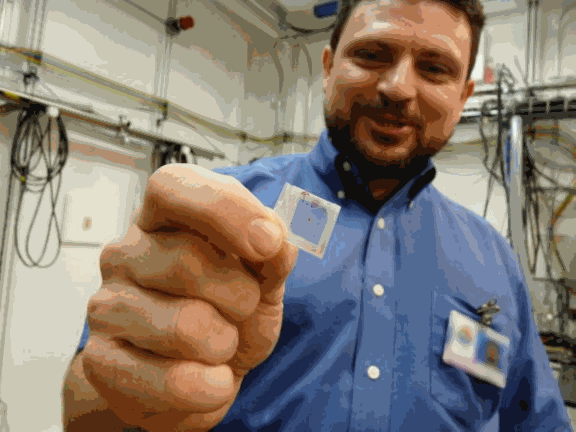Courtesy of WBEZ-Chicago
Dinosaurs loom large in our imaginations not just because they were in fact enormous, but also they are so ridiculously old. There has always been a big, impenetrable curtain separating us from prehistoric life. Sure, we have some ancient bones, but those had long since turned to stone. Any actual tissue, the stuff of flesh-and-blood creatures, is irrevocably lost, lasting only a few tens of thousands of years in most cases. Maybe a few stray organic molecules could persist for a few million if, say, they were frozen deep within primeval ice.
So, needless to say, it came as something of a shock when Mary Schweitzer discovered that she had some 68-million-year-old dinosaur tissue on her hands.
The find was and is controversial. Many scientists are skeptical or outright dismissive of the idea that tissue could have persisted inside the partially fossilized thigh bone of a T. rex. But since then Schweitzer and her collaborators have gradually built up evidence that the find is real. And most recently, Joseph Orgel of the Illinois Institute of Technology has begun to understand how mummified dino-flesh could possibly have survived a thousand times longer than was thought possible.
Orgel used [high-brightness x-rays from the Biophysics Collaborative Access Team synchrotron x-ray facility at the U.S. Department of Energy Office of Science’s Advanced Photon Source at Argonne National Laboratory to carry out] x-ray diffraction, a kind of molecular imaging technique, to understand how the dinosaur tissue is structured in detail. The particular stuff they have in hand is collagen, a material found in our bones, tendons, blood vessels and skin. It is itself a hardy molecule, and Orgel found that the protein sequences preserved in their fossils came from the innermost, protected part of the collagen fiber. So it’s possible that collagen’s tough, ropelike structure preserved a tender bit of dinosaur jerky inside.
Keep in mind, this is not DNA. We will not be cloning Barney from this stuff. But understanding how these proteins can be shielded from decay for so long could hold practical lessons for modern medicine. If you’re repairing, say, a bone or cartilage, you might be able to leverage or mimic nature’s ability to make durable organic materials that don’t degrade, in effect, forever.
The Clever Apes page for this experiment can be found here.
Don’t forget to subscribe to the Clever Apes podcast, follow Clever Apes on Twitter, and find Clever Apes on Facebook.
Copyright 2012 Chicago Public Media
For more on this subject see the science highlight “How Dinosaurs Put Proteins into Long-Term Storage” on the Advanced Photon Source website at "How Dinosaurs Put Proteins into Long-Term Storage"
This research was funded by NIH RR 08630 and an NSF Career Award 0644015 to JPROO; NIH DK 55001 grant to RK; and grants from NSF and The David and Lucile Packard Foundation to MHS. The Biophysics Collaborative Access Team facility is funded by grants from the National Center for Research Resources (2P41RR008630-17) and the National Institute of General Medical Sciences (9 P41 GM103622-17) from the National Institutes of Health.
Use of the Advanced Photon Source at Argonne National Laboratory was supported by the U. S. Department of Energy, Office of Science under Contract No. DE-AC02-06CH11357.
The Advanced Photon Source at Argonne National Laboratory is one of five national synchrotron radiation light sources supported by the U.S. Department of Energy’s Office of Science to carry out applied and basic research to understand, predict, and ultimately control matter and energy at the electronic, atomic, and molecular levels, provide the foundations for new energy technologies, and support DOE missions in energy, environment, and national security.
Argonne National Laboratory seeks solutions to pressing national problems in science and technology. The nation's first national laboratory, Argonne conducts leading-edge basic and applied scientific research in virtually every scientific discipline. Argonne researchers work closely with researchers from hundreds of companies, universities, and federal, state and municipal agencies to help them solve their specific problems, advance America's scientific leadership and prepare the nation for a better future. With employees from more than 60 nations, Argonne is managed by UChicago Argonne, LLC for the U.S. Department of Energy's Office of Science.
The Advanced Photon Source at Argonne National Laboratory is one of five national synchrotron radiation light sources supported by the U.S. Department of Energy’s Office of Science to carry out applied and basic research to understand, predict, and ultimately control matter and energy at the electronic, atomic, and molecular levels, provide the foundations for new energy technologies, and support DOE missions in energy, environment, and national security. To learn more about the Office of Science x-ray user facilities, visit http://science.energy.gov/user-facilities/basic-energy-sciences/.
Argonne National Laboratory seeks solutions to pressing national problems in science and technology. The nation's first national laboratory, Argonne conducts leading-edge basic and applied scientific research in virtually every scientific discipline. Argonne researchers work closely with researchers from hundreds of companies, universities, and federal, state and municipal agencies to help them solve their specific problems, advance America's scientific leadership and prepare the nation for a better future. With employees from more than 60 nations, Argonne is managed by UChicago Argonne, LLC for the U.S. Department of Energy's Office of Science.

